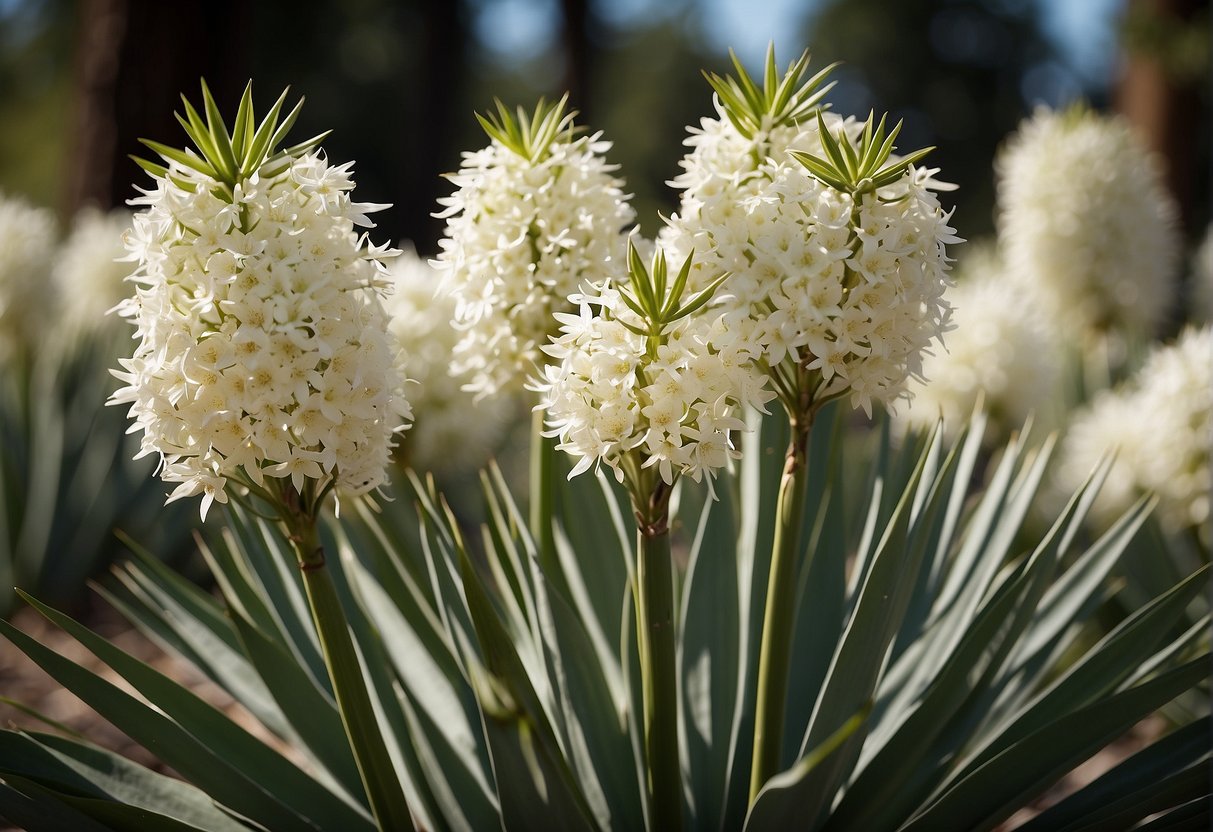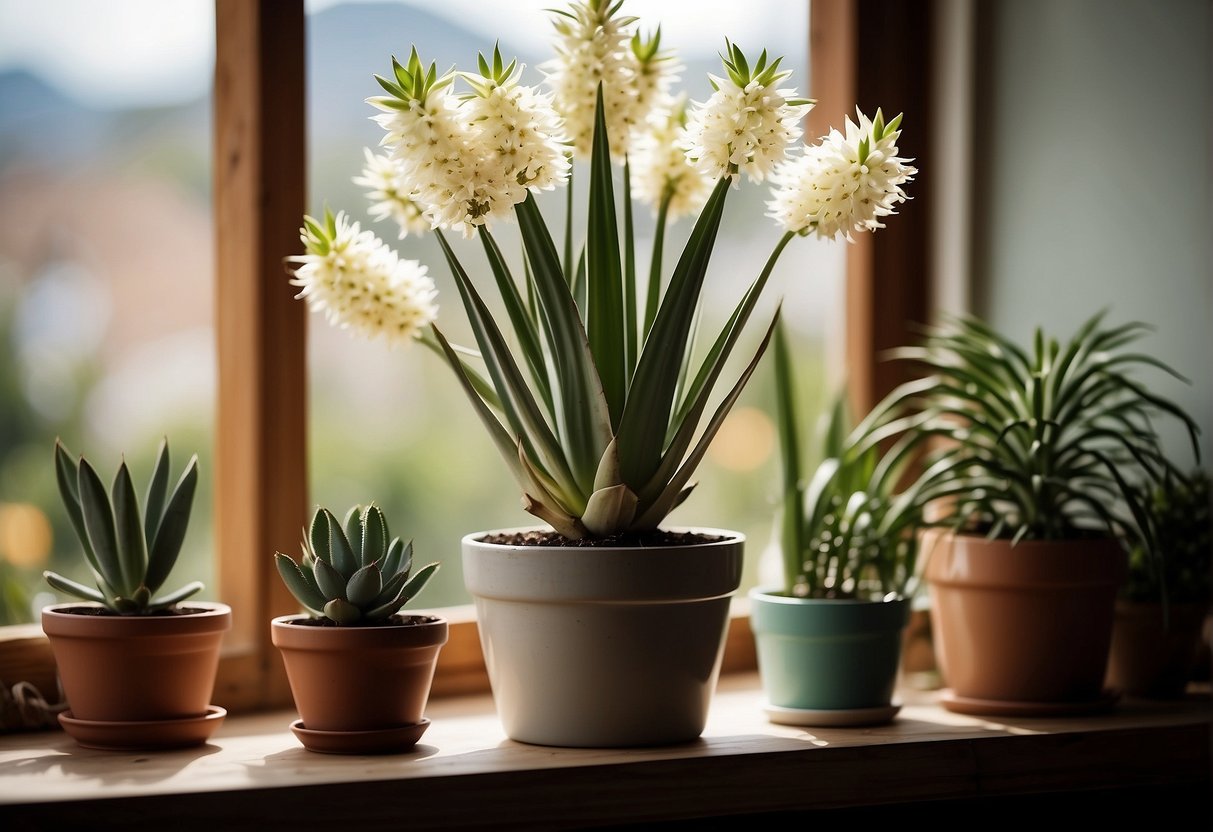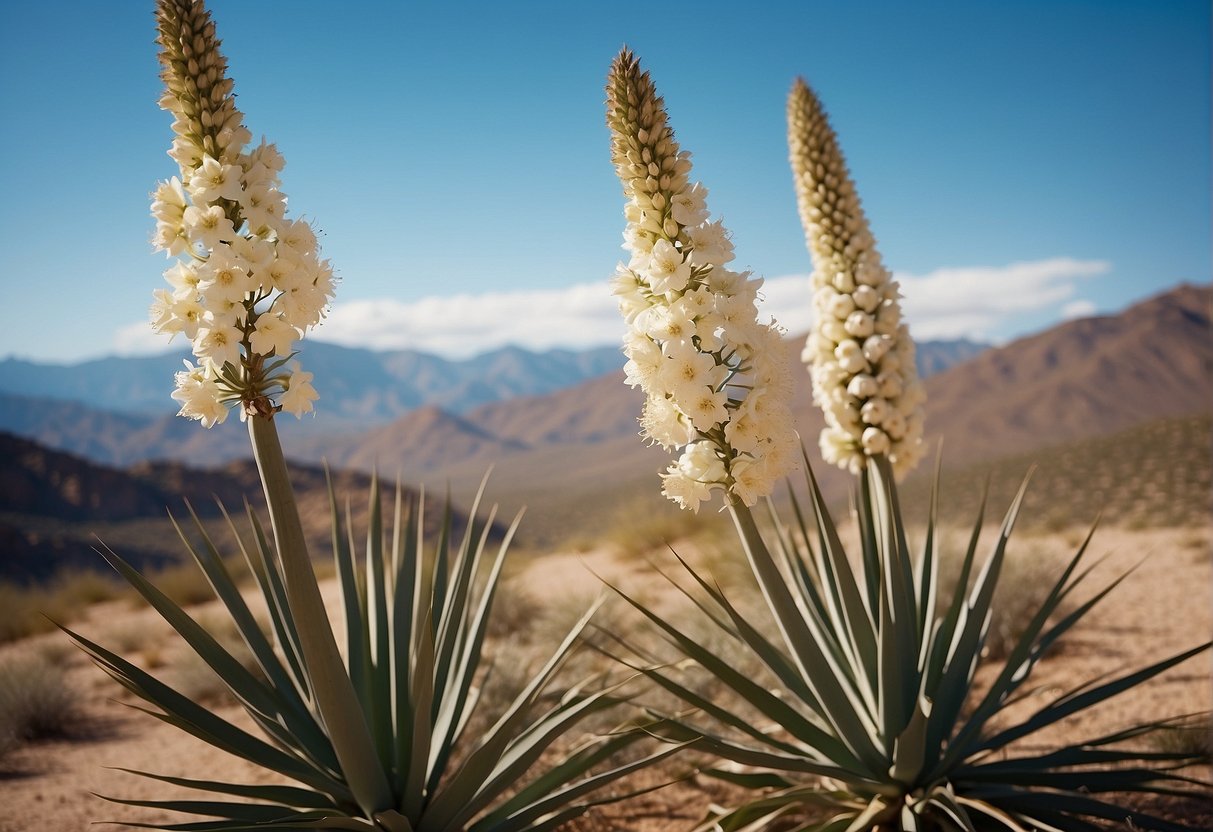How Often Do Yucca Plants Bloom: Frequency and Factors of Their Flowering Cycle
Yucca plants, notable for their distinct outline and robustness, offer an intriguing option for those gardeners looking to infuse an exotic flair into their outdoor spaces. Belonging to the Asparagaceae family, these durable plants are characterized by their evergreen, tough, sword-like leaves and substantial clusters of white or nearly white blossoms at their apex. A frequent inquiry concerns their flowering patterns: what is the typical frequency of yucca blossoms? The occurrence of blooms in yuccas can greatly vary, influenced by factors such as the variety of the plant, its maturity, and the specific environmental conditions it experiences.

While some yucca species can bloom each year once they reach maturity, others may take several years to produce their first flowers. The blooming of yucca plants typically occurs in the warmer months, with some variation across species and regional climates. It is not uncommon for a yucca to skip a year or even several years between blooms, particularly if it has experienced stress or suboptimal conditions. Proper care involving adequate sunlight, well-draining soil, and minimal watering can increase the likelihood of regular flowering. When yuccas do bloom, their impressive flowers are usually tall and stately, attracting various pollinators such as moths and, depending on the region, hummingbirds.
Key Takeaways
- Yucca plants are drought-tolerant and flower atop tall stalks.
- Bloom frequency varies by species, age, and care, ranging from yearly to several years apart.
- Optimal care, involving sunlight and well-draining soil, promotes more regular blooming.
Understanding Yucca Plants
Yucca plants are diverse and display unique adaptability across various habitats. Your appreciation for these plants will deepen as you discover their species, physical traits, and natural environments.
Species and Family
Yuccas belong to the genus Yucca within the family Asparagaceae, which includes other notable members such as the agave plant. With over 40 species in the genus, yuccas have a wide distribution mainly focused in the Americas, especially North America, Mexico, and the Caribbean. A few species, such as the Spanish bayonet (Yucca aloifolia), are native to the southeastern United States, extending to areas like Florida.
- Common Yucca Species:
- Yucca aloifolia – Spanish bayonet
- Yucca filamentosa – Adam’s needle
- Yucca brevifolia – Joshua tree
- Yucca glauca – Soapweed yucca
Physical Characteristics
The physical form of yucca plants can vary greatly in size and shape, but they typically feature a rosette arrangement of tough, sword-like leaves. These leaves are often a vibrant green color and have a spiky appearance. During their bloom cycle, yuccas produce impressive stalks of white flowers, which stand out against their evergreen foliage.
- Typical Characteristics:
- Leaves: Spiky sword-like, evergreen
- Flowers: White, bell-shaped
- Height: Ranges from 1 to 30 feet
Yucca Plant Habitats
Yuccas are synonymous with dry, arid regions such as deserts, where they thrive under full sunlight and with minimal water. These resilient plants have adapted to harsh conditions in various habitats, predominantly within North America, including the Mexican desert and in Florida environments.
- Habitat Preferences:
- Region: Dry, arid climates of the Americas
- Sunlight: Prefers full sun exposure
- Soil: Well-drained, sandy soils
Cultivation and Care

To ensure a thriving yucca plant, key factors such as proper soil, light requirements, watering schedules, and maintenance practices must be attentively managed.
Soil and Drainage
Your yucca plant will prosper in a well-drained soil, preferably a mix that is sandy or contains coarse material. Optimal soil pH should be between 5.5 and 7.5. Ensure that the soil allows for adequate drainage to prevent root rot.
- Soil types suitable for yucca:
- Sandy Loam
- Cactus Mix
- Drainage optimization:
- Add perlite or gravel
- Ensure pots have drainage holes
Light and Temperature
Yucca plants demand full sun to partial shade to grow well. They are able to withstand high heat and bright light. When grown indoors, place your yucca near a window where it receives ample sunlight. Ideal temperature conditions range from 60°F to 95°F.
- Light requirements:
- Minimum of 6 hours of direct sunlight
- Temperature tips:
- Avoid temperatures below 30°F
Watering and Feeding
As drought-tolerant plants, yuccas require minimal watering. During the growing season, water your plant when the top inch of soil is dry. Decrease the frequency of watering in the winter. Overwatering can lead to root problems. For feeding, a light application of fertilizer such as bone meal can aid in nutrient provision.
- Watering schedule:
- Spring through fall: when topsoil is dry
- Winter: sparingly
- Fertilizing:
- Once in spring with low-nitrogen fertilizer
Pruning and Maintenance
Regularly inspect your yucca for pests like aphids, mealybugs, and scale. These can often be treated naturally with horticultural oil sprays. Pruning is essential to remove dead or damaged leaves and can be done by cutting at the base of the leaf. In addition, periodic cleaning of the leaves can help in maintaining the plant’s health.
- Pruning guidance:
- Cut at leaf base with clean, sharp shears
- Pest Control:
- Check regularly and treat with appropriate methods
Yucca Blooms
Yucca plants provide a magnificent display when they bloom, producing towering flower stalks adorned with large, bell-shaped flowers. Understanding their flowering frequency, pollination process, and post-blooming care will maximize the display and health of your yucca plants.

Flowering Frequency
Yucca plants generally bloom once each year, although the exact timing can vary depending on the species and environmental conditions. They typically reach maturity and start blooming once they are several years old. Your plant’s ability to produce flowers is also influenced by factors such as light exposure and watering:
- Light: Yuccas need full sun to produce flowers.
- Watering: They require well-drained soil and only occasional watering.
Pollination and Seed Formation
Flowers on yucca plants range in color from white to cream and, less commonly, yellow or purple. These flowers are primarily pollinated by yucca moths, which play a crucial role in the formation of seeds. Here’s how the process works:
- Moths and Blooms: The yucca moths ensure pollination by carrying pollen from flower to flower as they lay their eggs inside the flower head, leading to the development of seeds.
- Seed Formation: Once pollinated, the flowers start to develop seed pods.
Post-Blooming Care
After your yucca plant has finished blooming, certain care steps are necessary to maintain plant health and prepare it for the next blooming cycle.
- Flower Stalk: Once the flowers have withered, you should cut the flower stalk about 3 to 4 inches above where it emerges from the main foliage to encourage new growth.
- Cleanup: Remove any debris or dead flowers around the plant to prevent disease.
- Monitoring: Keep an eye on your yucca for signs of pests or diseases and treat accordingly.
Maintaining these simple aftercare steps ensures your yucca will continue to produce its striking panicles year after year.
Propagation Methods
Yucca plants can be propagated through various methods, ensuring growth and multiplication. You have options including seeds and cuttings, or even using offsets and pups, depending on your preference or availability of materials.
Seeds and Cuttings
To propagate yucca plants from seeds, begin by sowing them in well-draining soil, covering lightly with sand. It’s critical to keep the soil moist until germination, which typically occurs in 3-4 weeks. Once seedlings grow strong enough, transplant them to individual pots.
For cuttings, take a healthy piece from an adult yucca plant during the active growth period. Cut sections of the stem or use leaf cuttings, and allow them to dry for several days before planting. Plant the cuttings in sandy soil, ensuring the end with the previous growth is facing up. Water sparingly until roots form.
Offsets and Pups
Offsets are small yucca plants that grow at the base of a mature plant. When they reach a reasonable size, carefully separate them from the parent plant with a sharp, clean knife. Allow the offset to dry for a few days to heal the wound and prevent rot.
Similarly, yucca pups are the young plants that form around the base of the parent. You can remove pups in the same way as offsets. After separation, plant the pups in individual pots with well-draining soil. Make sure the environment is warm and sunny to encourage strong root development.
Varieties and Their Uses
When selecting a yucca plant for your garden, you have a range of species to choose from, each with unique characteristics and uses. Understanding the common varieties and how they can enhance your landscape is crucial for successful cultivation.
Common Yucca Varieties
- Yucca aloifolia: Often called the Spanish bayonet, this shrub features stiff, sword-shaped leaves and is a hardy, perennial favorite. Typical of its kind, it forms a rosette and can grow quite tall.
- Yucca gloriosa: Known as the Spanish dagger, this variety has a tree-like growth habit with flexible, sword-shaped leaves. It suits most gardens with its moderate height.
- Yucca gigantea: Also known as the spineless yucca or giant yucca, this species presents a softer leaf texture and can attain impressive heights, making it a striking selection for indoor and outdoor settings.
Landscaping and Aesthetic Value
Yucca plants serve multiple functions in landscaping. Their rosettes of sword-shaped leaves add an architectural element to your garden, catching the attention of passersby with their bold and versatile presence. As perennials, they offer year-round greenery, and their statuesque, tree-like appearance can create focal points within your outdoor space. Incorporating yucca into your garden elevates the overall aesthetic, providing a rugged yet sophisticated charm that resonates with the advice provided by numerous gardening experts, including those from the “Gardening Know How” newsletter and associated eBooks.
Yucca Plant Problems and Solutions
Yucca plants face various issues that can hinder their growth, including diseases, pests, and environmental stress. Knowing how to identify and address these problems effectively will ensure your yucca plants thrive.
Addressing Common Diseases
Yucca plants can succumb to several diseases, such as root rot, caused by excessive moisture. To prevent this:
- Ensure proper drainage: Plant your yucca in well-draining soil and pots with drainage holes.
- Water judiciously: Water your plant only when the top inch of the soil is dry.
Leaf spot is another disease that can cause brown or black spots on the leaves. Here’s what you can do:
- Remove affected leaves to prevent the spread of the disease.
- Apply a fungicide recommended for yuccas if the infection persists.
Managing Pests
Pests like aphids, mealybugs, and scale can attack yucca plants, draining their sap and weakening them. Address these pests by:
- Inspecting your plants regularly for signs of infestation.
- Using a strong stream of water to dislodge light infestations.
- Applying insecticidal soap or neem oil to treat and prevent heavier infestations.
For persistent pest problems, consider:
- Introducing beneficial insects such as ladybugs or lacewings to naturally control the pests.
- Contacting a professional for advice if the infestation is severe and widespread.
Avoiding Environmental Stress
Yuccas are drought-tolerant, but environmental stress like overwatering or inadequate sunlight can cause issues. To promote a healthy plant:
- Provide adequate sunlight: Ensure your yucca gets at least 6 hours of sunlight per day.
- Regulate watering: Overwatering can stunt growth and cause root rot. Water sparingly.
In cases of drought, yucca plants are resilient; however:
- Give the plant a deep watering occasionally during extended dry periods.
- Mulch around the base of the plant to help retain soil moisture.
Additional Information and Resources
In this section, you’ll find targeted resources that will provide you with in-depth knowledge on nurturing your yucca plants and encouraging them to bloom.
Gardening Tips Newsletter
Subscribe to a gardening tips newsletter to stay informed about the latest techniques in yucca care. Newsletters can offer:
- Monthly Care Reminders: Timely advice on watering, fertilizing, and pruning.
- Seasonal Guides: Specifically tailored to help your yucca flourish throughout the year.
Instructional Videos
Seek out instructional videos that demonstrate yucca plant care. These videos can be valuable for:
- Visual Learning: Clear demonstrations of care techniques.
- Expert Advice: Insights from experienced gardeners who specialize in yucca plants.
Frequently Asked Questions
Yucca plants bloom with striking precision, and understanding their flowering habits can greatly enhance your appreciation and care for these plants.
At what time of year do yucca plants typically flower?
Yucca plants often bloom in the late spring to early summer. The exact timing can vary depending on the species and local climatic conditions.
Is it possible for indoor yucca plants to produce flowers?
Yes, indoor yucca plants can flower, but they require sufficient light and proper care. Flowering indoors is less common and often requires significant patience and ideal growing conditions.
What should be done with a yucca plant after it has finished flowering?
After a yucca plant has finished flowering, the flower stalk should be cut back to its base. This helps the plant conserve energy and may encourage future growth.
Why might a yucca plant fail to produce flowers?
A yucca plant may fail to bloom due to inadequate sunlight, improper watering, nutrient deficiencies, or the plant’s age. Yuccas typically need full sun and time to mature before they can produce flowers.
Can you eat the flowers of a yucca plant, and are they safe for consumption?
Yes, the flowers of many yucca species are edible and safe for consumption when properly prepared. They are often used in salads and can be cooked as well.
How do you promote regular blooming in yucca plants?
To promote regular blooming, ensure your yucca plant receives full sunlight, moderate water, and is in well-draining soil. Fertilize during the growing season and allow the plant to experience winter dormancy if outdoors.



